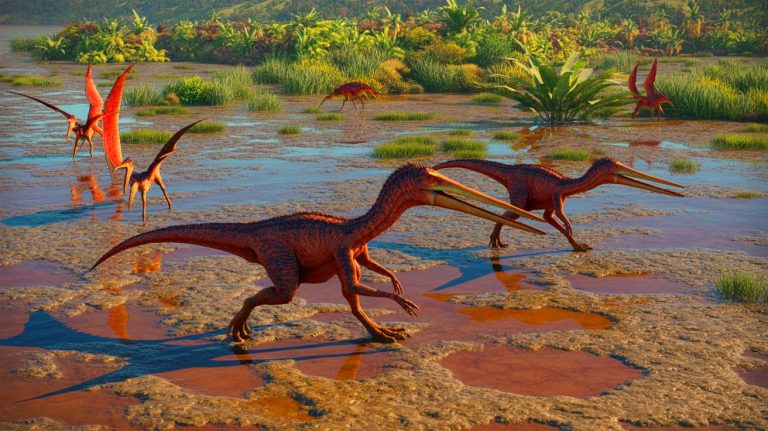| IN A NUTSHELL |
|
In the fascinating world of paleontology, ancient tracks offer a window into the lives of creatures that roamed the Earth millions of years ago. Recent discoveries have revealed surprising insights about pterosaurs, the flying reptiles of the dinosaur era. Traditionally envisioned as creatures of the sky, new research suggests these reptiles were also adept at navigating terrestrial landscapes. Through the study of fossilized footprints, scientists have uncovered evidence that these flying giants underwent an ecological shift around 160 million years ago, adapting to life on land. This breakthrough enriches our understanding of how pterosaurs lived and interacted with their environment, challenging long-held perceptions.
Unveiling the Habitats of Ancient Pterosaurs
Footprints have long been a source of intrigue in paleontology, offering a unique glimpse into the lives of ancient creatures. Recent research conducted by the University of Leicester has brought to light the favored habitats of pterosaurs through meticulous study of fossilized tracks. These footprints, found in various global locations, indicate that pterosaurs were not confined to the skies but were well-adapted to terrestrial environments. The findings suggest that these creatures experienced an ecological shift, allowing them to thrive on land alongside dinosaurs.
By employing cutting-edge 3D modeling, researchers have reconstructed these ancient trackways, providing insights into the behavior and daily activities of pterosaurs. According to Robert Smyth, the lead author of the study, footprints offer a rare opportunity to study pterosaurs in their natural habitat. They reveal not only where these creatures lived but also how they moved and interacted with their ecosystem. This research underscores the importance of footprints in understanding the biology and ecology of pterosaurs, offering clues about their lifestyle that skeletal remains alone cannot provide.
Breakthrough air-powered tech claims to recycle 94% of plastic in just 4 hours using moisture
Tracks Left by the Largest Pterosaur
Pterosaurs, the first vertebrates to achieve powered flight, lived during the Mesozoic Era. However, recent discoveries indicate that several groups, including neoazhdarchians, ctenochasmatoids, and dsungaripterids, adapted to spend more time on land. The ecological shift allowed these pterosaurs to explore terrestrial habitats, fostering their evolution into versatile creatures. This adaptation is vividly illustrated by the neoazhdarchian footprints, which reveal that even the largest pterosaurs, such as Quetzalcoatlus with its impressive wingspan of almost 33 feet, were not solely creatures of the air.
The discovery of pterosaur footprints in both coastal and inland regions worldwide highlights their adaptability. These long-legged giants frequently dwelled on the ground, sharing habitats with numerous dinosaur species until the end of the dinosaur age. The study of these tracks has provided invaluable information about the movement, behavior, and ecological interactions of pterosaurs, enriching our understanding of their place in prehistoric ecosystems.
Breakthrough air-powered tech claims to recycle 94% of plastic in just 4 hours using moisture
Technological Advances in Paleontology
The study of ancient footprints has been revolutionized by technological advances, allowing researchers to gain deeper insights into the lives of extinct creatures. At the forefront of this research is the use of 3D modeling to reconstruct fossilized trackways. This technology enables scientists to create detailed representations of ancient footprints, revealing the shape, depth, and pressure of each step. Such analysis sheds light on the biomechanics of pterosaur movement and their interactions with the environment.
The University of Leicester’s use of false-color depth maps has further enhanced the understanding of pterosaur locomotion. These maps illustrate how pterosaurs distributed their weight while walking, indicating that they bore more weight on their hands. Such findings have profound implications for reconstructing the posture and movement of these ancient creatures. By combining technological innovation with paleontological expertise, researchers continue to uncover the secrets of the past, offering a more nuanced view of pterosaur ecology and behavior.
Breakthrough air-powered tech claims to recycle 94% of plastic in just 4 hours using moisture
The Role of Pterosaur Research in Modern Science
The study of pterosaurs is not only vital for understanding prehistoric life but also contributes to broader scientific knowledge. Research on these flying reptiles provides insights into the evolution of flight, biomechanics, and ecological adaptations. The ecological shift observed in pterosaurs, as revealed by their footprints, highlights the dynamic nature of evolution and the ability of species to adapt to changing environments. This research also emphasizes the importance of interdisciplinary collaboration, combining paleontology, technology, and biology to unravel the mysteries of the past.
As scientists continue to study pterosaur footprints, they uncover new layers of complexity in these ancient creatures’ lives. The findings challenge existing narratives and inspire further exploration into the diverse adaptations of prehistoric species. With each discovery, paleontologists are reminded of the vast, untapped potential of the fossil record and the endless possibilities for understanding the history of life on Earth.
The study of pterosaur tracks offers a compelling narrative of adaptation and survival in prehistoric times. As researchers delve deeper into the fossilized footprints, they continue to uncover the secrets of these remarkable creatures. This research not only enhances our understanding of pterosaurs but also raises intriguing questions about the evolutionary pathways of other ancient species. What other hidden stories do the rocks and fossils of our planet hold, waiting to be unearthed by future generations of scientists?
Did you like it? 4.6/5 (21)











This article blew my mind! 🧠 Who knew pterosaurs were such versatile creatures?
How do scientists determine the exact age of these footprints? 🤔
Great read! Thanks for sharing this amazing discovery. 😊
Wait, so pterosaurs were like the original multitaskers? Flying & walking? That’s wild! 😂